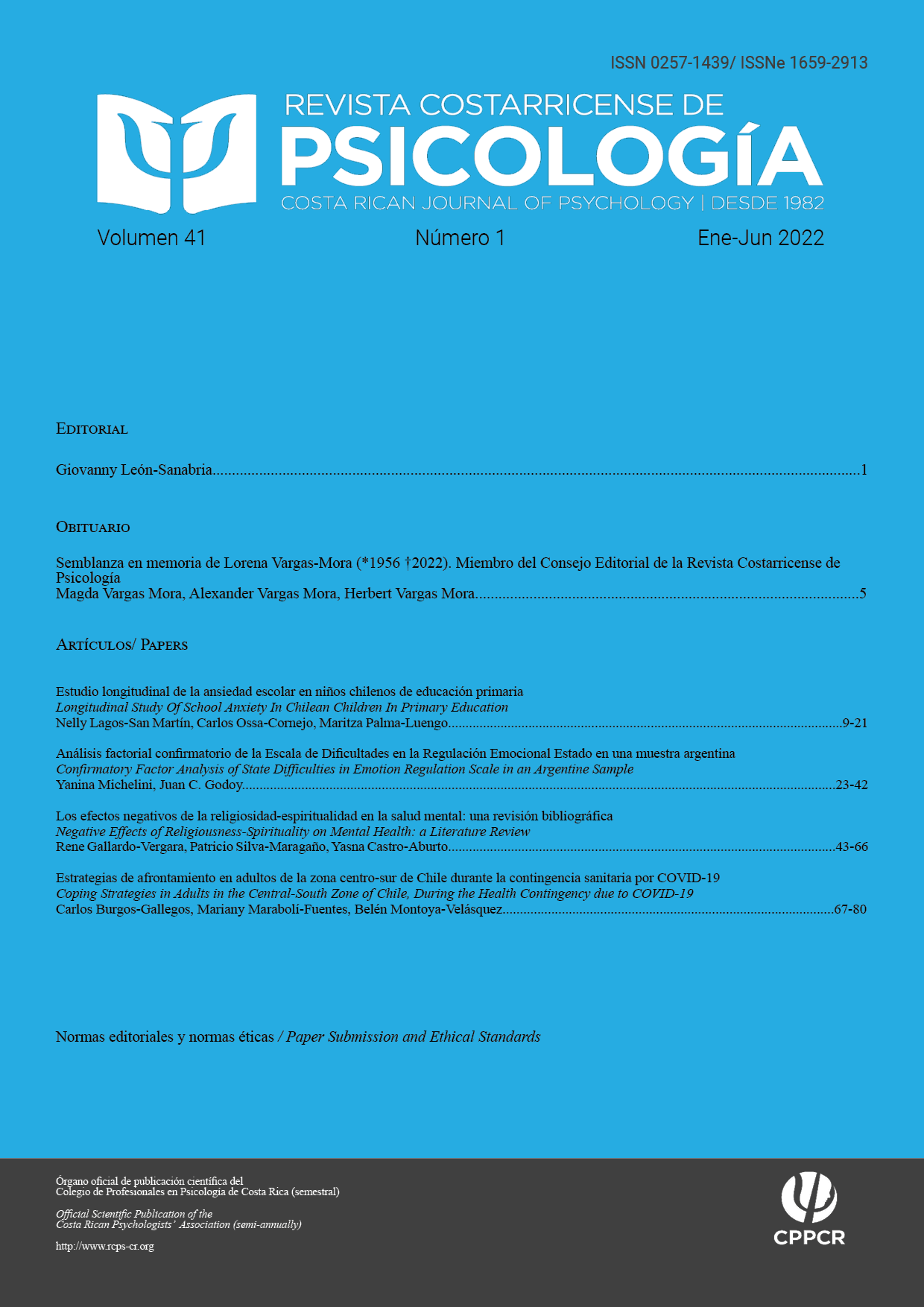Longitudinal Study Of School Anxiety In Chilean Children In Primary Education
DOI:
https://doi.org/10.22544/rcps.v41i01.01Keywords:
School anxiety, Longitudinal study, Primary educationAbstract
Since the three-dimensional theory, school anxiety is defined as a set of symptoms arising from three response systems. The objective of this study was to evaluate school anxiety responses in Chilean primary school students, during three consecutive years, to determine possible changes over time. To this end, 155 children from three different courses were included; they were evaluated for their level of school anxiety for three consecutive years. The instrument used for this was the School Anxiety Inventory for Primary Education (IAEB), which measures the cognitive, psychophysiological and motor anxiety responses. Analysis of variance of repeated measures was performed to determine temporal stability. The results indicated that the mean did not show statistically significant differences, maintaining school anxiety in these children over the three-year period, supporting the possibility that it appears as a stable symptom of the students, rather than responding to specific events in the environment.References
Axelsson, L., & Ejlertsson, G. (2002). Self-reported health, self-esteem and social support among Young unemployed people: a population-based study. International Journal of Social Welfare, 11(2), 11-119. https://doi.org/10.1111/1468-2397.00205
American Psychiatric Association. (2018). Actualización del DSM-5 Octubre 2018. Suplemento del Manual Diagnóstico y Estadístico de Trastornos Mentales (5a ed.). American Psychiatric Association Publishing.
Avello, R. (2020). ¿Por qué reportar el tamaño del efecto? Apuntes escuela de autores. Revista Comunicar, 137, 1-10. https://doi.org/10.3916/escuela-de-autores-137
Becht, A. I., Nelemans, S. A., Branje, S. J. T., Vollebergh, W. A. M., Koot, H. M., Denissen, J. J. A., & Meeus, W. H. J. (2016). The quest for identity in adolescence: Heterogeneity in daily identity formation and psychosocial adjustment across 5 years. Developmental Psychology, 52(12), 2010–2021. https://doi.org/10.1037/dev0000245
Bornás, C., Severa, M., & Llabres, J. (1996). Prevención de la ansiedad en escolares. Ansiedad y Estrés, 2(2-3), 283-295.
Burnham, J. J. (2009). Contemporary fears of children and adolescents: Doping and resiliency in the 21st century. Journal of Counseling and Development, 87(1), 28-35.
Cano-Vindel, A., & Miguel-Tobal, J.J. (1994). Psicología Medicina y Salud (Monografía de Ansiedad y Estrés). Compobell.
Cano-Vindel, A. (2003). Desarrollos actuales en el estudio del control emocional. Ansiedad y Estrés, 9(2-3), 2003-229.
Cano-Vindel, A., & Miguel-Tobal, J. J. (2001). Ansiedad y Estrés. Emociones y Salud, 7(2-3), 111-121.
Carroll, M.K., & Ryan-Wenger, N.A. (1999). Miedos, ansiedad y dibujos de figuras humanas de niños en edadescolar. Journal of Pediatric Health Care, 13(1), 24-31.
Celis, J., Bustamante, M., Cabrera, D., Cabrera, M., Alarcón, W., & Monge, E. (2001). Ansiedad y Estrés Académico en Estudiantes de Medicina Humana del Primer y Sexto Año. Anales de la Facultad de Medicina, 62(1), 25-30. https://doi.org/10.15381/anales.v62i1.4143
Costello, E. J., Angold, A., Burns, B. J., Stangl, D. K., Tweed, D. L., Erkanli, A., & Worthman, C. M. (1996). The Great Smoky Mountains study of youth: Goals, design, methods, and the prevalence of DSM–III–R disorders. Archives of General Psychiatry, 53, 1129 –1136.
Cova S, F., Rincón G, P., & Melipillán A, R. (2009). Reflexión, Rumiación Negativa y Desarrollo de Sintomatología Depresiva en Adolescentes de Sexo Femenino. Terapia psicológica, 27(2), 155-160. https://dx.doi.org/10.4067/S0718-48082009000200001
Criado, R., & Mengual, Y. (2017). Anxiety and EFL speaking in Spanish compulsory and non-compulsory secondary education: A mixed-method study. Miscelánea: A Journal of English and American Studies, 55, 13-35.
Freudenthaler, H. H., Spinath, B., & Neubauer, A. C. (2008). Predicting School Achievement in Boys and Girls. European Journal of Personality, 22(3), 231-245. https://doi.org/10.1002/per.678
García-Fernández, J. M., Inglés, C. J., Torregrosa, M. S., Ruiz-Esteban, C., Díaz-Herrero, A., Pérez-Fernández, E., & Martínez-Monteagudo, M. C. (2010). Propiedades psicométricas de la Escala de Autoeficacia Percibida Específica de Situaciones académicas en una muestra de estudiantes españoles de Educación Secundaria Obligatoria. European Journal of Educational Psychology, 3(1), 61-74.
García-Fernández, J. M., Inglés, C. J., Martínez-Monteagudo, M. C., Marzo, J. C., & Estévez, E. (2011). Inventariode Ansiedad Escolar: Validación en una muestra de estudiantes de Educación Secundaria. Psicothema,23(2), 301–307.
García-Fernández, J. M., Martínez-Monteagudo, M. C., & Inglés, C. (2011). Diferencias según género y curso em ansiedad escolar: estudio con una muestra de estudiantes españoles de educación secundaria. Ansiedad y Estrés, 17(2), 137–148.
Gómez-Núñez, M.I., Aparisi-Flores, M.P., Vicent, M., Aparisi-Sierra, D., Fernández-Sogorb, A., J., & Inglés, C. (2017). Diferencias en ansiedad escolar en función del sexo y del curso académico en educación primaria. International Journal of Developmental and Educational Psychology, 3(1), 51-60.
Gonzálvez, C., Inglés, C., Vicent, M., Lagos, N., Sanmartín R., & García-Fernández, J.M. (2016). Diferencias en ansiedad escolar y autoconcepto en adolescentes chilenos. Acta de Investigación Psicológica, 6(3), 2509-2515.
Haynes, S., & Wilson, C. (1979). Behavioral assessment: Recent Advances in Methods, Concepts and Applications. Jossey Bass Publishers.
Kaplan, D. S., Liu, R. X., & Kaplan, H. B. (2005). School related stress in early adolescence and academic performance three years later: the conditional influence of self-expectations. Social Psychology of Education, 8, 3-17. https://doi.org/10.1007/s11218-004-3129-5
Lagos, N., Vicent, M., Gonzálvez, C., Sanmartín, R., & García-Fernández, J.M. (2018). Diferencias en ansiedade escolar en función del sexo y el curso académico en una muestra de estudiantes chilenos de educación básica. Psicología desde el Caribe, 35(3), 242-251. https://doi.org/10.14482/psdc.35.3.152.46
Lang, P.J. (1968). Fear reduction and fear behavior: Problems in treating a construct. En J.U.H Shilen (Ed.), Research in psychotheraphy (vol 3, pp. 90-102). American Psychological Association.
Lazarus, R. S. (1976). Discussion. En G. Serban (Ed.), Psychopathology of human adaptation. Plenum.
Legkauskas, V., Magelinskaitė-Legkauskienė, Š., & Kepalaitė, A. (2019). Does learning-related social competence in the 1st grade predict academic achievement in the 3rd grade? Social Psychology of Education 22, 673–685.
Legkauskas, V., & Magelinskaitė-Legkauskienė, S. (2021). Social competence in the 1st grade predicts school adjustment two years later. Early Child Development and Care, 191(1), 83-92. https://doi.org/10.1080/03004430.2019.1603149
Navas, J. (1989). Ansiedad en el Tema de Exámenes: Algunas Explicaciones cognoscitivas conductuales. Revista Aprendizaje y Comportamiento, 7(1), 21-41.
Nelemans, S.A., Hale, W.W., Branje, S.J., Raaijmakers, Q.A., Frijns, T., van Lier, P.A., & Meeus, W.H. (2014). Heterogeneity in development of adolescent anxiety disorder symptoms in an 8-year longitudinal Community study. Development and Psychopathology, 26(1), 181-202. https://doi.org/10.1017/S0954579413000503
Martínez-Monteagudo, M.C., Inglés, C.J., Trianes, M.V., & García-Fernández, J.M. (2011). Perfiles de ansiedad escolar: diferencias en clima social y violencia entre iguales. Electronic Journal of Research in Educational Psychology, 9(25), 1023–1042.
Martínez-Monteagudo, C. Inglés, C.J., Cano Vindel, A., & García-Fernández, J.M. (2012). Estado actual de la investigación sobre la teoría tridimensional de la ansiedad de Lang. Ansiedad y Estrés, 18(2-3), 2201-219
Martínez-Monteagudo, M.C., García-Fernández, J.M., & Inglés, C.J. (2013). Relaciones entre ansiedad escolar, ansiedad rasgo, ansiedad estado y depresión en una muestra de adolescentes españoles. International Journal of Psychology and Psychological Therapy, 13(1), 47-64.
Méndez, F.X, Inglés, C.J., Hidalgo, Ma. D., García- Fernández, J.M., & Quiles, M.J. (2003). Los miedos en la infancia y la adolescencia: Un estudio descriptivo. Revista Electrónica de Motivación y Emoción (REME), 6(13), 4-16. http://reme.uji.es/articulos/amxndf4650710102/texto.html
Mendoza, R., Dorantes, R., Cedillo, J., & Jasso, X. (2017). El método estadístico de análisis discriminante como herramienta de interpretación del estudio de adicción al móvil, realizado a los alumnos de la Licenciatura en Informática Administrativa del Centro Universitario UAEM Temascaltepec. RIDE. Revista Iberoamericana para la Investigación y el Desarrollo Educativo, 7(14), 222-247. https://doi.org/10.23913/ride.v7i14.282
Orgilés, M., Méndez, X., Espada, J.P., Carballo, J.L., & Piqueras, J.A. (2012). Anxiety disorder symptoms in children and adolescents: Differences by age and gender in a community sample. Revista de Psiquiatría y Salud Mental (English Edition), 5(2), 115-120. https://doi.org/10.1016/j.rpsm.2012.01.005
Paulus, Daniel J. Gallagher, M., Zvolensky, W., Michael, J., Leventhal, A. M. (2021). Reciprocal longitudinal associations between anxiety sensitivity and alcohol consumption/problems across adolescence: Examining anxiety as a mediator and race/ethnicity as a moderator. Behaviour Research and Therapy, 142 (103861). https://doi.org/10.1016/j.brat.2021.103861
Ratanova, T.A., & Likhacheva, E.V. (2009). Correlation of School Anxiety with cognitive peculiarities of Junior School Children. Psikholgicheskii Zhurnal, 30(3), 39-51.
Rodríguez, B., & Vetere, R. (2010). Ansiedad rasgo y creencias relacionadas con trastornos de ansiedad: Una comparación entre el trastorno de ansiedad generalizada y otros cuadros de ansiedad. Perspectivas en Psicología: Revista de Psicología y Ciencias Afines, 7(1), 8-15.
Sandín, B., & Chorot, P. (2011). Concepto y categorización de los trastornos de ansiedad. En A. Belloch, B. Sandín y F. Ramos (Eds.), Manual de psicopatología (ed.rev., vol. 2, pp. 43-63). McGrawHill.
Sandoval, J., Barriga, G., Wylie, C., Cuadra, D., Palacios, D., & Storey, R. (2018). Configuraciones subjetivas de psicólogos ante la vulnerabilidad escolar: el programa HPV. Revista de Psicología, 27(1), 211-223. https:// dx.doi.org/10.5354/0719-0581.2018.50757
Si, J., Guo, K., Zhao X., Zhang, M., Li, H., Huang, B., & Xu, Y. (2022). Transition of latent classes of children’s mathematics anxiety in primary school and the distinctive effects of parental educational involvement: A three-wave longitudinal study. Acta Psychologica Sinica, 54(4), 355-370. https://doi.org/10.3724/SP.J.1041.2022.00355
Sorvo, R., Koponen, T., Viholainen, H., Aro, T., Räikkönen, E., Peura, P., Tolvanen, A., & Aro, M. (2019). Development of math anxiety and its longitudinal relationships with arithmetic achievement among primary school children. Learning and Individual Differences, 69,173-181. https://doi.org/10.1016/j.lindif.2018.12.005
Spielberg, C.D. (1980). Test Anxiety Inventory: Preliminary profesional manual. Consulting Psychologist Press.
Van-Ameringen, M., Mancini, C., & Farvolden, P. (2003). The impact of anxiety disorders on educational achievement. Journal of Anxiety Disorders, 17(5), 561-571.
Published
How to Cite
Issue
Section
License
Copyright (c) 2022 Costa Rican Journal of Psychology

This work is licensed under a Creative Commons Attribution-NonCommercial-NoDerivatives 4.0 International License.
El Colegio, como institución editora, tiene todos los derechos reservados (copyright) sobre lo que se publica en la revista. Los autores y las autoras firman una declaración de cesión de derechos de autoría en el caso de aceptación de sus manuscritos para publicación en la revista, conforme con lo establecido en la legislación vigente.
Los artículos publicados representarán el punto de vista de su autoría y no de la revista, por lo que la autoría asume responsabilidad ante cualquier litigio o reclamación relacionada con derechos de propiedad intelectual y exonera de cualquier responsabilidad a la Revista Costarricense de Psicología y al Colegio.
La revista publicará en cada edición su política de acceso abierto (p.ej., Creative Commons). El material publicado en la revista puede ser copiado, fotocopiado, duplicado y compartido siempre y cuando sea expresamente atribuido al Colegio. El material de la revista no puede ser usado para fines comerciales.







